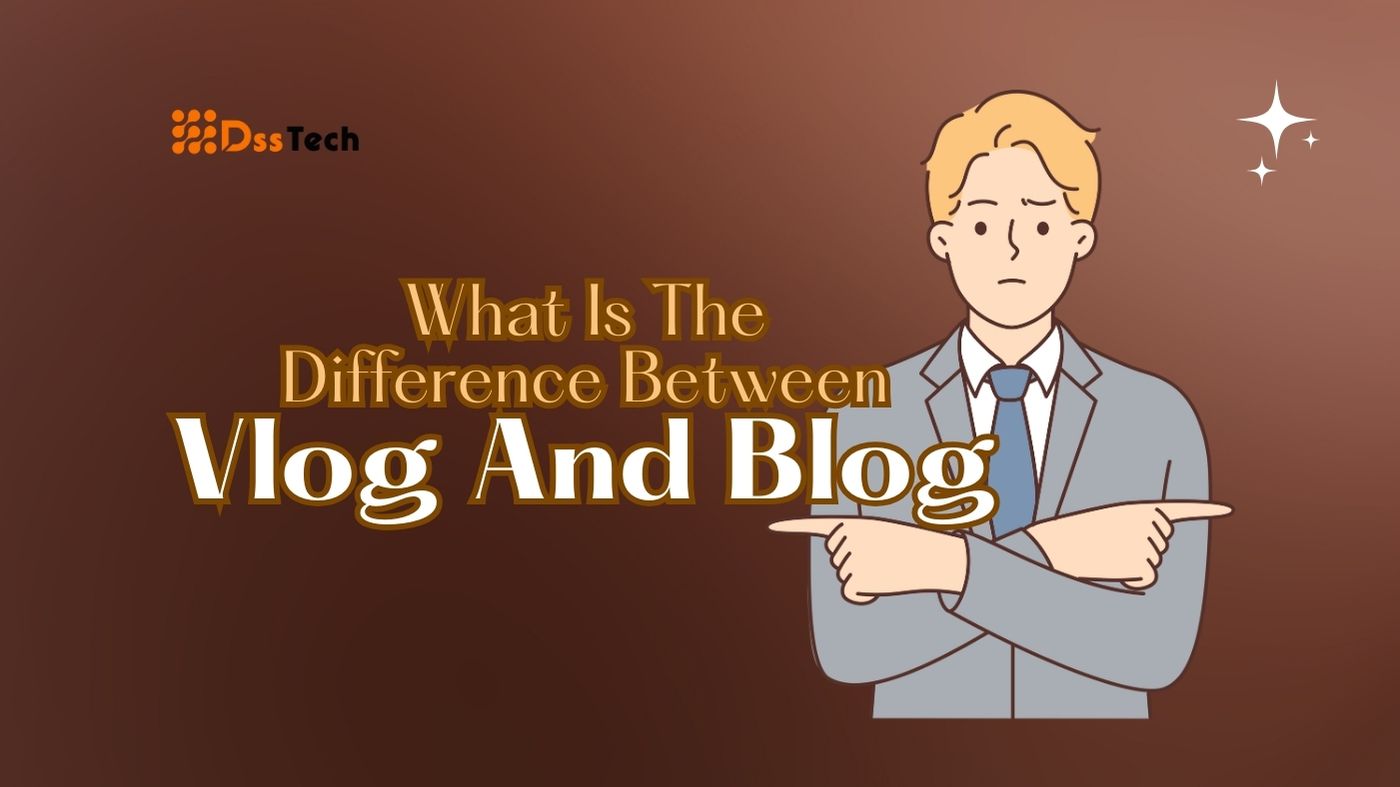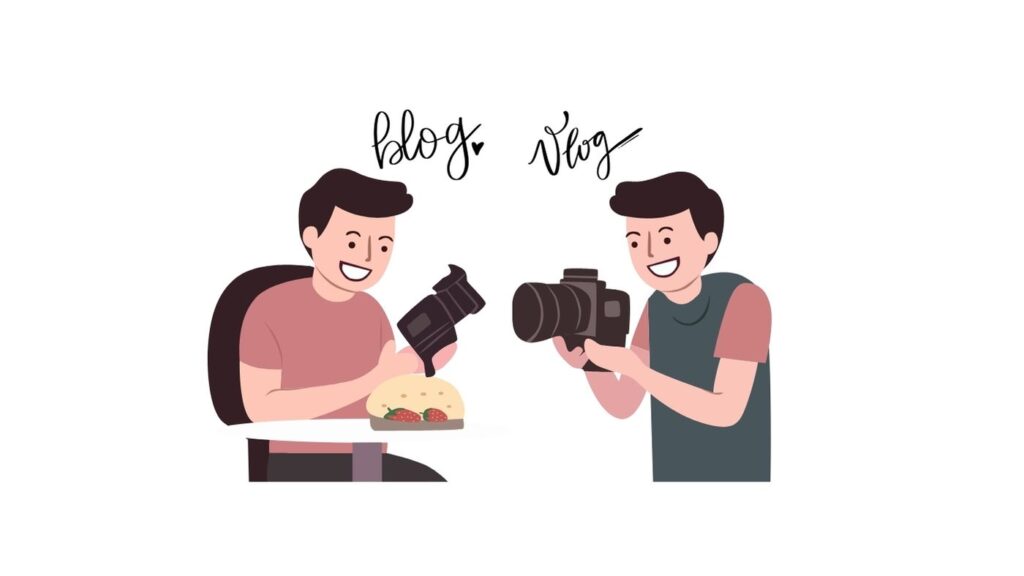Introduction: What is The Difference Between Vlog And Blog
In this interesting post, we are going to understand, what is the difference between Vlog and Blog. In today’s digital age, vlogs and blogs have become integral parts of online content creation and consumption. Vlogs, short for video blogs, and blogs, short for weblogs, offer unique ways for individuals and businesses to share their thoughts, experiences, and expertise with a global audience. Understanding the differences between these two mediums is important for anyone looking to engage with online content effectively.
1. Definition of Vlog and Blog
A vlog is a form of blog where the medium is primarily video. Vlogs can feature a wide range of content, including personal commentary, travel experiences, tutorials, and product reviews. They are typically hosted on platforms like YouTube and Vimeo and have gained immense popularity due to their visual appeal and personal nature.
On the other hand, a blog is a website or web page that contains written content. Blogs can cover a wide range of topics, from personal diaries to professional advice, and are often accompanied by images, videos, or other multimedia elements. They are typically hosted on blogging platforms like WordPress, Blogger, or Medium.
2. Format
The format of a vlog revolves around video content, with creators recording themselves or their surroundings to convey their message. Vlogs can vary in length, style, and production quality, ranging from casual, handheld recordings to professionally edited videos with high production value.
Blogs, on the other hand, are primarily text-based, with written articles forming the core content. Blogs can vary in length and style, from short and concise posts to long and detailed articles. They often include images, infographics, or other visual elements to enhance the reading experience.
3. Content
In terms of content, vlogs often focus on providing a personal perspective or sharing real-life experiences. Vloggers may document their daily lives, travel adventures, or special events, allowing viewers to connect with them on a more personal level. Additionally, vlogs are popular for tutorials, product reviews, and commentary on current events or trends.
Blogs, on the other hand, offer a more versatile platform for content creation. Bloggers can write about virtually any topic, ranging from personal stories and opinions to informative articles and how-to guides. Blogs are often used for sharing in-depth knowledge, research, and insights on specific subjects, making them a valuable resource for readers seeking detailed information.
4. Engagement
In terms of engagement, vlogs have the advantage of being more visually and audibly stimulating than blogs. The combination of video and audio elements allows vloggers to convey emotions, expressions, and nuances that may be lost in written text. This visual and auditory engagement can create a more immersive and compelling viewing experience for audiences, leading to higher levels of engagement and interaction.
Blogs, on the other hand, can also be engaging but in a different way. Well-written blog posts can captivate readers with compelling storytelling, insightful analysis, and thought-provoking ideas. Additionally, blogs often allow for more interactive elements, such as comments, social sharing, and multimedia content, which can further enhance engagement and encourage reader participation.
5. Accessibility
In terms of accessibility, the Difference Between a Vlog And a Blog is clear. Vlogs require an internet connection to watch, which may limit their accessibility in areas with poor or limited internet connectivity. Additionally, some people may prefer to consume content in written form, making blogs a more accessible option for those individuals.
Blogs, on the other hand, can be accessed offline once the page has been loaded, making them more accessible in situations where internet access is limited or unavailable. This offline accessibility makes blogs a more practical choice for readers who want to consume content on the go or in remote locations.
6. Monetization
Both vlogs and blogs offer monetization opportunities, allowing creators to earn income from their content. Vloggers can monetize their videos through advertising, sponsorships, and product placements. They can also sell merchandise, offer premium content, or engage in crowdfunding to support their vlogging efforts.
Bloggers, on the other hand, can monetize their blogs through various channels, such as advertising, affiliate marketing, sponsored content, and selling digital or physical products. Additionally, bloggers can leverage their expertise and influence to offer consulting services, workshops, or online courses, further expanding their revenue streams.
7. Popularity and Trends
In terms of popularity and trends, what is the difference between Vlog and Blog? Vlogs have seen a significant rise in popularity in recent years, thanks to platforms like YouTube, TikTok, and Instagram. Vloggers have amassed large audiences and loyal followings, making vlogging a lucrative career choice for many content creators.
Blogging, on the other hand, has been around for much longer and continues to be a popular form of content creation, highlighting the Difference Between a Vlog And a Blog. While the blogging landscape has evolved over the years, with new platforms and technologies emerging, blogs remain a valuable medium for sharing information, ideas, and stories with a global audience.
In conclusion, while both vlogs and blogs offer unique ways to create and consume content, they differ in format, content, engagement, accessibility, monetization, and popularity. Vlogs are video-based, offering a more visually and audibly engaging experience, while blogs are text-based, offering a more versatile platform for in-depth content creation. Depending on your content goals and audience preferences, you can choose to focus on one medium or incorporate both into your content strategy for a more comprehensive approach.
Definition of Vlog and Blog
A vlog, which is short for “video blog,” is a type of blog that primarily uses video as its medium. Vlogs can feature a wide range of content, including personal commentary, travel experiences, tutorials, and product reviews. They are typically hosted on platforms like YouTube and Vimeo and have gained immense popularity due to their visual appeal and personal nature.
On the other hand, a blog, short for “weblog,” is a website or web page that contains written content. Blogs can cover a wide range of topics, from personal diaries to professional advice, and are often accompanied by images, videos, or other multimedia elements. They are typically hosted on blogging platforms like WordPress, Blogger, or Medium.
Highlight the Main Difference: Vlogs are Video-Based, While Blogs are Text-Based
The main difference between a vlog and a blog lies in their medium of communication. Vlogs rely on video content, where the creator records themselves or their surroundings to convey their message. This video content is typically accompanied by audio, allowing vloggers to add commentary, background music, or other sound effects to enhance the viewing experience.
On the other hand, blogs are primarily text-based, with written articles forming the core content. While blogs can include images, videos, or other multimedia elements, the primary mode of communication in a blog is written text. This written content allows bloggers to convey information, ideas, and stories in a detailed and structured manner, making blogs a valuable resource for readers seeking in-depth knowledge on a particular topic.
Format
1. Vlogs: Vlogs are recorded videos that often feature a person or a group of people talking directly to the camera or demonstrating something, illustrating the difference between a Vlog And a Blog. They can range from casual, everyday vlogs where individuals share their daily experiences and thoughts, to more structured vlogs that focus on specific topics such as travel, fashion, or cooking.
The format of a vlog can vary depending on the creator’s style and the intended audience. Some vlogs may be short and to the point, while others may be longer and more detailed. Vloggers often use editing techniques to enhance the visual appeal of their videos, adding music, graphics, and special effects to engage viewers and make their content more entertaining.
One of the key features of vlogs is their personal and intimate nature. Vloggers often share personal stories, thoughts, and emotions with their audience, creating a sense of connection and community. Viewers are able to see the vlogger’s personality and life firsthand, which can make vlogs more relatable and engaging than other forms of content.
2. Blogs: Blogs, on the other hand, are written articles that are published on a website or blog platform. They can cover a wide range of topics, from personal reflections and opinions to informative guides and tutorials.
The format of a blog post can vary depending on the author’s style and the purpose of the post. Some blog posts may be short and concise, while others may be longer and more in-depth. Blogs often include images, infographics, or other visual elements to enhance the reading experience and illustrate key points.
One of the advantages of blogs is their versatility. Bloggers can experiment with different writing styles and formats to suit their audience and the topic they are covering. This flexibility allows bloggers to create engaging and informative content that resonates with their readers.
In summary, vlogs are recorded videos that often feature personal stories and experiences, while blogs are written articles that can cover a wide range of topics. Both formats offer unique ways to communicate and engage with an audience and can be effective tools for sharing information and ideas online.
Content
1. Vlogs: Vlogs often focus on providing a personal perspective or sharing real-life experiences with viewers. Vloggers may take their audience along on their daily adventures, share insights into their thoughts and emotions, or document significant events in their lives. This personal approach allows viewers to connect with the vlogger on a more intimate level, creating a sense of camaraderie and community.
In addition to personal stories, the difference between vlogs and blogs is clear vlogs are also popular for tutorials and instructional content. Vloggers may create videos demonstrating how to cook a certain dish, how to apply makeup, or how to perform a particular task. These tutorials are often presented in a friendly and accessible manner, making them easy for viewers to follow along and replicate in their own lives.
Overall, the content of a vlog is often driven by the vlogger’s personality and interests. Vloggers may choose to focus on a specific niche or topic that they are passionate about, such as travel, fashion, or fitness, or they may create more general vlogs that cover a variety of topics. The key is to create content that resonates with their audience and keeps them coming back for more.
2. Blogs: Blogs offer a versatile platform for content creation, allowing bloggers to cover a wide range of topics and styles. One of the most common types of blog content is personal stories and reflections. Bloggers may share anecdotes from their own lives, discuss their thoughts and feelings on various topics, or offer insights into their experiences.
In addition to personal stories, blogs are also popular for how-to guides and tutorials. Bloggers may create step-by-step guides on how to do something, such as cooking a recipe, fixing a household appliance, or learning a new skill. These guides are often detailed and informative, providing readers with practical advice and actionable tips.
Another common type of blog content is informational articles. Bloggers may write about current events, trends, or topics of interest, offering their insights and analysis to their readers. These articles can be educational and thought-provoking, encouraging readers to engage with the content and share their own opinions and experiences.
Overall, the content of a blog can vary widely depending on the blogger’s interests and expertise. Some bloggers may focus on a specific niche or topic, while others may write about a variety of subjects. The key is to create content that is informative, engaging, and valuable to the reader, keeping them coming back for more.
Engagement
1. Vlogs: Vlogs have a unique advantage in terms of engagement due to their visual and auditory elements. Video content allows vloggers to convey emotions, expressions, and nuances that may be difficult to capture in written text alone. This visual and auditory stimulation can create a more immersive and compelling viewing experience for viewers, drawing them in and keeping them engaged throughout the video.
In addition to the content itself, vlogs also allow viewers to connect more personally with the vlogger. Seeing and hearing the vlogger speak directly to the camera can create a sense of intimacy and authenticity that is often lacking in other forms of media. Viewers may feel like they are getting to know the vlogger on a more personal level, which can lead to a stronger bond and a more loyal following.
Furthermore, vlogs often include interactive elements such as comments, polls, and annotations, which can further enhance engagement. These features allow viewers to interact with the content and with other viewers, creating a sense of community and participation that can be highly engaging.
2. Blogs: While blogs may not have the same visual and auditory appeal as vlogs, they can still be engaging through other means. Well-written content is key to keeping readers engaged, as it allows them to easily understand and connect with the information being presented. A well-written blog post can captivate readers with compelling storytelling, insightful analysis, and thought-provoking ideas, keeping them interested and invested in the content.
In addition to well-written content, blogs can also use images, infographics, and other visual elements to enhance engagement. Visuals can help break up the text, making the content more visually appealing and easier to digest. They can also help illustrate key points and concepts, making the content more informative and engaging.
Furthermore, blogs can include interactive elements such as comments, social sharing buttons, and links to related content, highlighting the difference between Vlog And Blog. These interactive elements can help create a sense of community around the blog, making readers feel more engaged and connected to the content and the blogger.
Overall, while vlogs may have an edge in terms of visual and auditory engagement, blogs can also be highly engaging through well-written content, images, and interactive elements. Both mediums offer unique ways to engage with an audience, and the key is to use a combination of elements to create content that is informative, entertaining, and engaging.
Accessibility
1. Vlogs: One of the main limitations of vlogs is their reliance on internet access. Vlogs are typically hosted on online platforms such as YouTube or Vimeo, which require an internet connection to stream. This means that viewers need to have access to a stable internet connection to watch vlogs, which may not always be possible in all situations.
For example, viewers in rural or remote areas with limited internet infrastructure may struggle to watch vlogs due to slow or unreliable internet connections. Similarly, viewers who are traveling or in areas with poor internet coverage may find it difficult to access vlogs, especially if they are streaming in high definition.
Additionally, vlogs may not be accessible to viewers with disabilities who rely on assistive technologies to access online content. For example, viewers who are deaf or hard of hearing may require captions or transcripts to understand the content of a vlog, which may not always be provided by vloggers.
2. Blogs: In contrast to vlogs, blogs can be accessed offline once they have been loaded onto a device. This means that readers can download and read blog posts without needing an internet connection, making them more accessible in areas with limited internet connectivity or no internet access at all.
Offline accessibility also makes blogs more practical for readers who want to consume content on the go, such as during a commute or while traveling. Readers can download blog posts in advance and read them at their leisure, without needing to worry about internet connectivity.
Furthermore, blogs are generally more accessible to viewers with disabilities, as they can be easily adapted to meet the needs of different users. For example, bloggers can provide alternative text for images, captions for videos, and accessible formatting for readers using screen readers.
Overall, while vlogs may be more engaging and visually appealing, blogs have the advantage of being more accessible, especially in areas with limited internet connectivity. Blogs offer a flexible and accessible platform for content consumption, making them a valuable medium for reaching a diverse audience.
Monetization
1. Vlogs: Vloggers have several options for monetizing their content. Advertising is one of the most common methods. Vloggers can partner with advertising networks or platforms like YouTube to display ads before, during, or after their videos. They can earn money based on the number of views or clicks these ads receive.
Another way vloggers can monetize their content is through sponsorships. Brands may pay vloggers to promote their products or services in their videos. This can take the form of a sponsored mention, product placement, or dedicated video review. Sponsored content can be a lucrative source of income for vloggers, especially if they have a large and engaged audience.
Additionally, vloggers can monetize their content by selling merchandise. They can create and sell branded merchandise such as clothing, accessories, or digital products like e-books or courses. This can be a great way for vloggers to generate additional revenue and engage with their audience on a deeper level.
2. Blogs: Bloggers can also monetize their blogs in various ways. Like vloggers, one common method is through advertising. Bloggers can display ads on their blogs using advertising networks like Google AdSense or through direct partnerships with advertisers. They can earn money based on the number of ad impressions or clicks their ads receive.
Bloggers can also monetize their blogs through sponsored content as another method. Brands may pay bloggers to write posts that promote their products or services. These posts are typically marked as sponsored or contain a disclosure to inform readers that the content is paid for.
Additionally, bloggers can earn money through affiliate marketing. This involves promoting products or services and earning a commission for each sale or referral made through their affiliate links. Bloggers can also sell products or services directly on their blogs, such as e-books, courses, or consulting services.
Overall, both vloggers and bloggers have multiple options for monetizing their content, including ads, sponsorships, affiliate marketing, and selling products or services. The key is to choose monetization strategies that align with their content and audience while maintaining authenticity and providing value to their viewers or readers.
Popularity and Trends
1. Vlogs: Vlogs have experienced a significant rise in popularity in recent years, thanks in large part to platforms like YouTube and TikTok. These platforms have provided vloggers with a global audience and a powerful medium for sharing their content. YouTube, in particular, has become a hub for vloggers, with channels dedicated to a wide range of topics, from travel and lifestyle to beauty and gaming.
The rise of short-form video content on platforms like TikTok has also contributed to the popularity of vlogs. TikTok’s algorithmic feed and focus on viral content have made it easier for vloggers to reach a wider audience and gain traction quickly. As a result, vlogs have become a popular form of entertainment and self-expression for millions of people around the world.
2. Blogs: Blogging, on the other hand, has been around much longer than vlogging and continues to be a popular medium for content creators. While the blogging landscape has evolved over the years, with the rise of social media and other forms of online content, blogs remain a valuable platform for sharing information, ideas, and stories.
One of the reasons for the enduring popularity of blogs is their versatility. Blogs can cover a wide range of topics and styles, allowing bloggers to tailor their content to suit their audience and their interests. Additionally, blogs are often valued for their in-depth written content, which can provide readers with detailed information and insights that may not be available in other forms of media.
In conclusion, while vlogs have seen a significant rise in popularity in recent years, especially on platforms like YouTube and TikTok, blogging remains a popular and valuable medium for content creators. Both vlogs and blogs offer unique ways to create and consume content, and the popularity of each medium is likely to continue as technology and consumer preferences evolve.
Conclusion
In summary, vlogs and blogs are two distinct mediums for content creation, each offering unique advantages and characteristics.
1. Recap the Main Differences between Vlogs and Blogs:
- Format: Vlogs are video-based, while blogs are text-based.
- Content: Vlogs often focus on personal experiences and tutorials, while blogs can cover a wide range of topics including personal stories, how-to guides, and informational articles.
- Engagement: Vlogs can be more engaging due to their visual and auditory elements, while blogs can also be engaging through well-written content and interactive elements.
- Accessibility: Vlogs require internet access to watch and may not be as accessible in all situations, while blogs can be accessed offline once loaded, making them more accessible in areas with limited internet connectivity.
- Monetization: Vloggers can monetize their content through ads, sponsorships, and merchandise, while bloggers can monetize their blogs through ads, sponsored content, affiliate marketing, and selling products or services.
- Popularity and Trends: Vlogs have seen a rise in popularity on platforms like YouTube and TikTok, while blogging has been around longer and continues to be popular, especially in niches where in-depth written content is valued.
2. Emphasize the Unique Aspects of Each Medium: Vlogs offer a more personal and immersive experience, allowing viewers to connect with the vlogger on a deeper level through visual and auditory elements. They are particularly popular for sharing personal experiences, tutorials, and product reviews.
On the other hand, blogs offer a versatile platform for content creation, allowing bloggers to cover a wide range of topics and styles. They are valued for their in-depth written content and are often used for sharing detailed information, insights, and opinions.
3. Catering to Different Preferences and Needs: Both vlogs and blogs have their own strengths and advantages, answering the question “What is the difference between vlog and blog?” Some people may prefer the visual and auditory experience of vlogs, while others may prefer the in-depth written content of blogs. Ultimately, the choice between vlogs and blogs depends on the content creator’s goals, audience preferences, and the nature of the content being shared.
In conclusion, both vlogs and blogs offer unique ways to create and consume content, and each has its own place in the digital landscape. Whether you prefer the personal touch of a vlog or the detailed analysis of a blog, both mediums provide valuable opportunities for sharing information, ideas, and stories with a global audience.











